Nora: Icon of the South
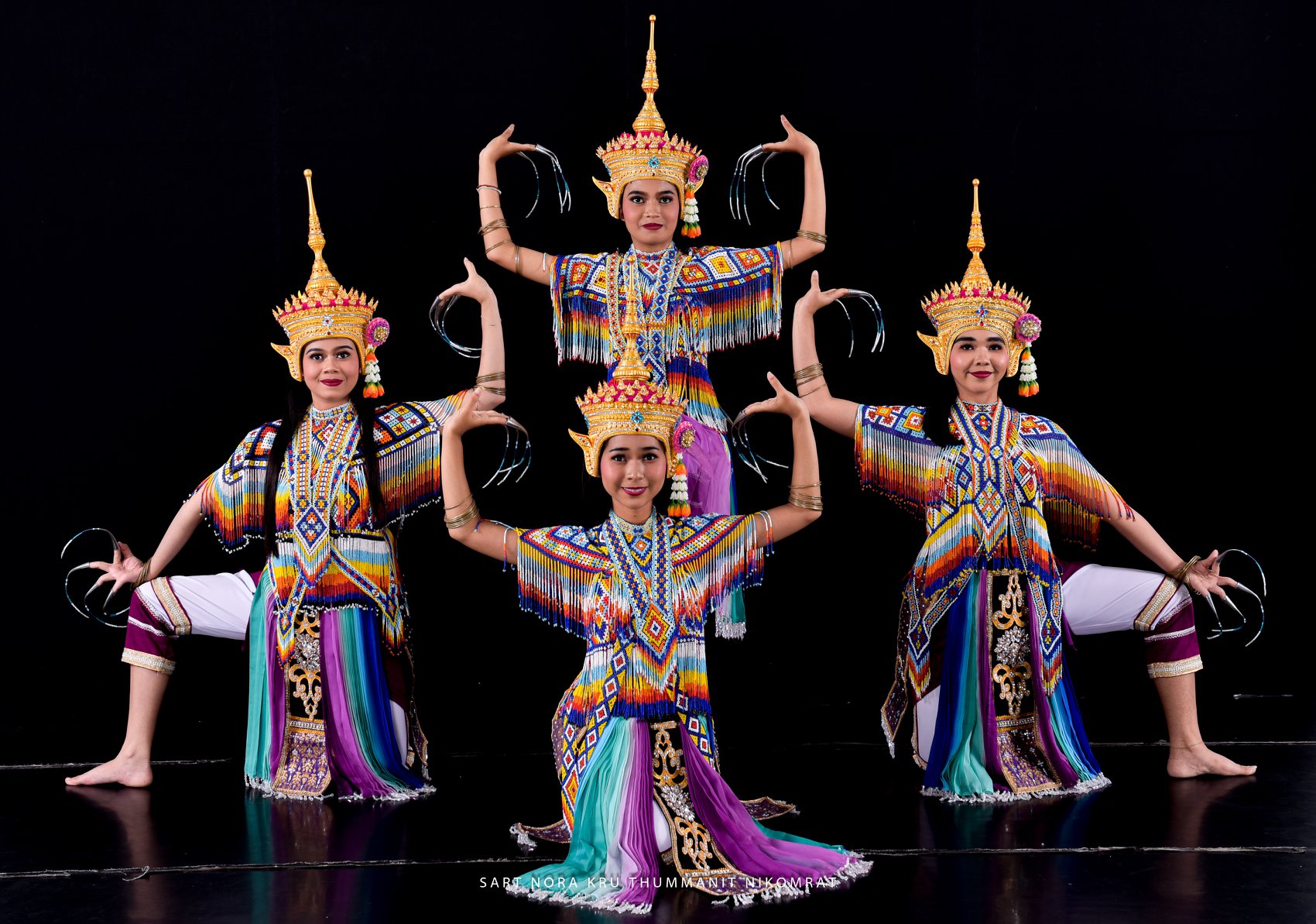
[cr. FB: Thummanit Nikomrat]
Nora (โนรา) is the soul of Southern Thailand. This unique performance art incorporates high discipline, trance-like music, unique poses with swift hand movements, and exquisite costumes consisting of colorfully beaded dress and a pointed headgear. The combination of all these components, along with the quick wit of the dancers, seem to best represent the extroverted, sophisticated, and fun-loving personality of the Southern Thai people.
The Origin of Nora
There are many legends to the origin to Nora, the most popular being the one told by Khun Upatham Narakorn Poomtewa (1892-1983).
In this version, a Princess named Nualthong Samlee dreamt of a spectacular dance performed by angels. When she woke up, she taught the ladies of the court all twelve dance poses she had witnessed in her dream.
The princess’s son grew up learning the dance from his mother. One day, he sneaked out and boarded a merchant ship, travelling to the mainland where he performed the special dance to earn a living. His unique and unmatched dancing skills captured the hearts of all those who witnessed. Hearing about the new dancer in town, Phraya Sai Fa Fard disguised himself as a commoner and went to see the performance.
Phraya Sai Fa Fard immediately recognized the dancer as his grandson, as the boy looked so much like Princess Nualthong Samlee. Full of regret, Phraya Sai Fa Fard sent his men to bring the princess back home. He allowed the princess to further practice the dance and gifted her and her son with a lavishly decorated set of regalia, including a pointed crown, arm bracelets, belt buckles, long cross-body chains, pants, and ornamental wings. These items would later become the Nora costume. His grandson, later appointed Khun Sri Sattha, went on to teach the dance to more people.

A statue of Khun Sri Sattha at Wat Tha Kae [cr. Manager Online]
The term “Nora” is derived from the folk tale called Manora that is popular among Thais, Laotians, Cambodians, and the Shan people of Myanmar. Each region has its own version and the name varies from Manora in Central Thailand to Sithon Manora in Laos and Phra Suthon Manora in Northern Thailand. When the story travelled down to the South, it was further interpreted and blended with local beliefs and lifestyle, leading to a new version with outstanding characteristics.
A general Nora performance is less concerned with storytelling and more focused on displaying the actors’ dance and singing skills. With enough time, however, the actors might put on a narrative play entertain the audiences. In that case, episodes from well-known stories are often depicted. The most popular tale to be portrayed is Monora, leading the dance style to be called Nora.
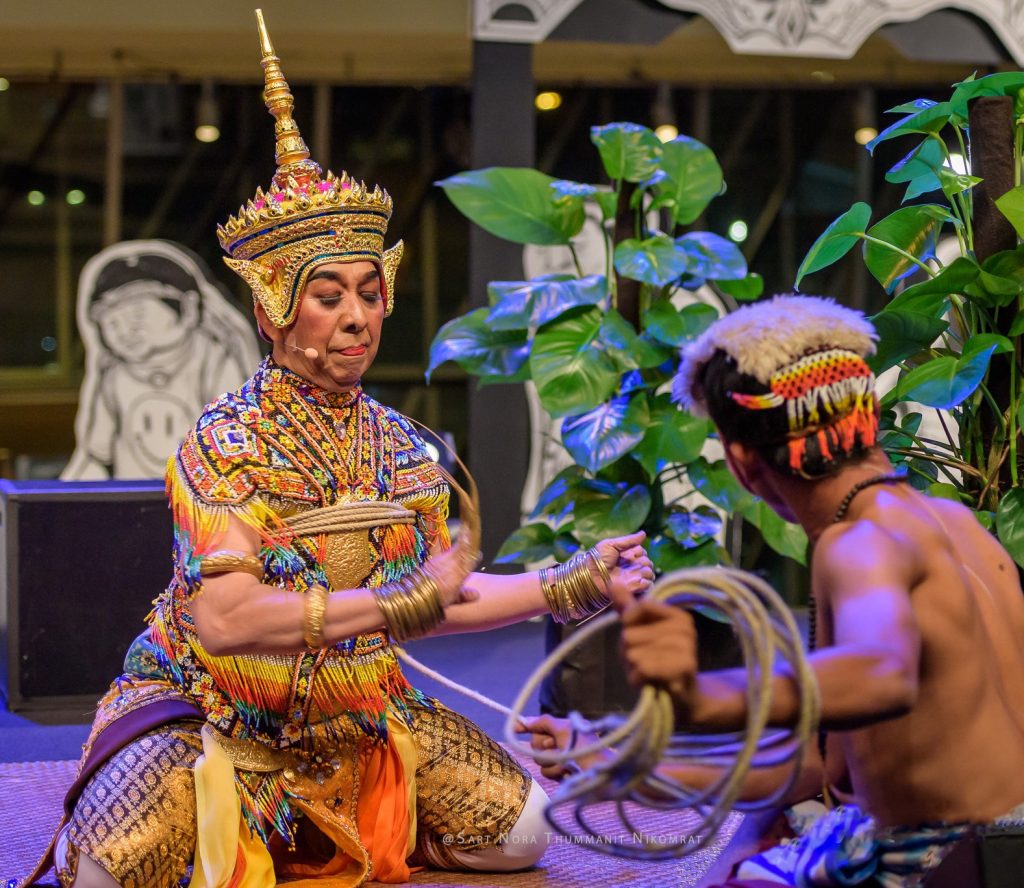
A performance of the Manora story [FB: Thammanit Nikomrat]
Choreography
The Nora choreography is swift, strong, and graceful. The unique characteristics of Nora moves lie in the main pose called tang wong (ตั้งวง), meaning bending the arms to a nice angle. Tang wong also accentuates the strength and muscle power needed to create the arm curves, sharp angles of the elbows, and smooth body movements, all enhanced by powerful twisting motions.
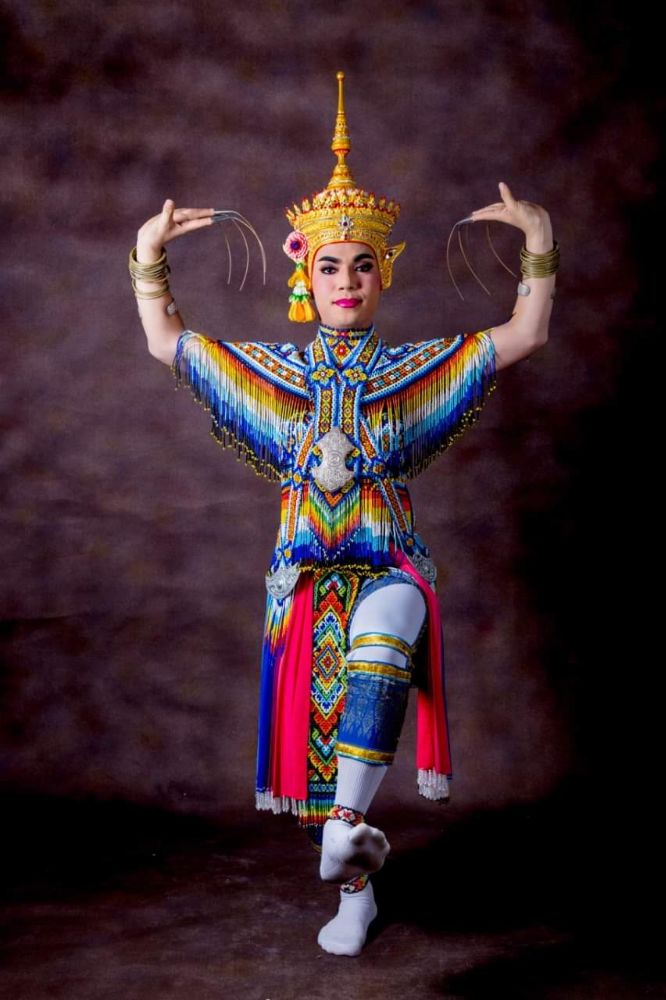
[cr. Dek-D]
With the body positioned straight and rigid, only the fingernails, hands, wrists, arms, neck, and face move uninterrupted. The tips of the feet move smoothly, yet powerfully. One of the most famous poses is the feet movement performed by Khun Upatham Narakorn Poomtewa which looked as if he floated like an angel.
Strength and flexibility are contradictory, yet both are combined in Nora. While some poses are unique with surprising flickers and long periods of standing on one leg, others force the performers’ flexibility to the max. Kneeling down on the floor and bending the head backward to meet the feet is one of the basic poses a Nora performer learns. Some moves are quite reminiscent of modern acrobatics.
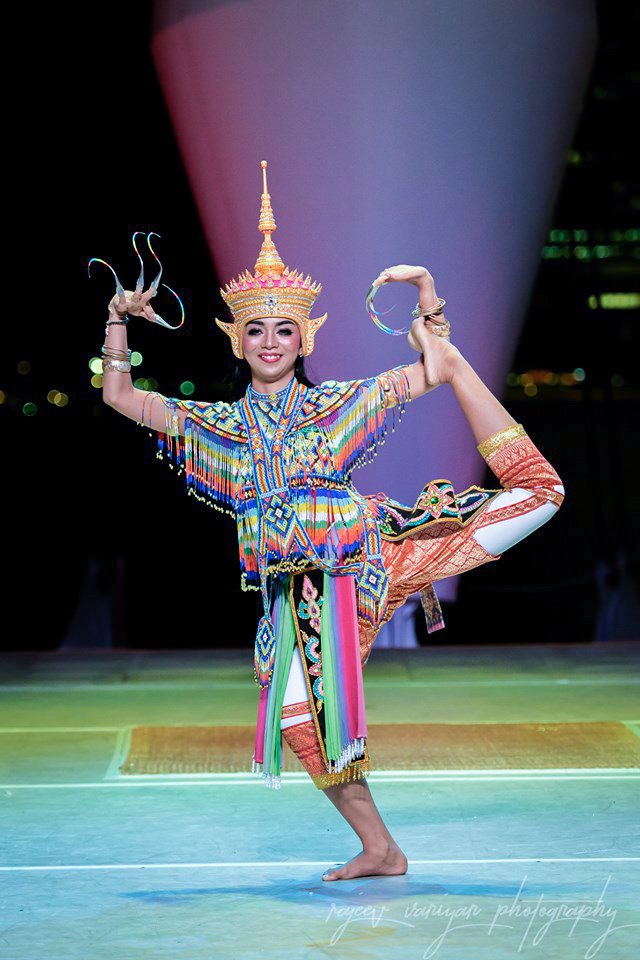 [FB: Thammanit Nikomrat]
[FB: Thammanit Nikomrat]
Nora actors are highly regarded for their exceptional skills and talents. People often add the honorific title “Nora” in front of performances name as a sign of admiration. For example, the legendary master Khun Upatham Narakorn (1891 – 1983) is widely known as Nora Poomtewa (โนราพุ่มเทวา) while Yok Chubua (1922 – 2006), a national artist, is called Nora Yok (โนรายก).
Costume
Some elements of Nora indicate royal influences. The clearest example is the serd (เทริด), a pointed headdress that resembles crowns of kings. Another costume component, the dress, is made of countless tiny beads woven together to form intricate, colorful patterns. Archaeological excavations in Southern Thailand have unearthed many beads which dated to the Srivijaya Empire (7th-13th century AD) and the Tambralinga Kingdom (10th-13th century AD). Based on these findings, many believe that beads were a part of ancient court life.
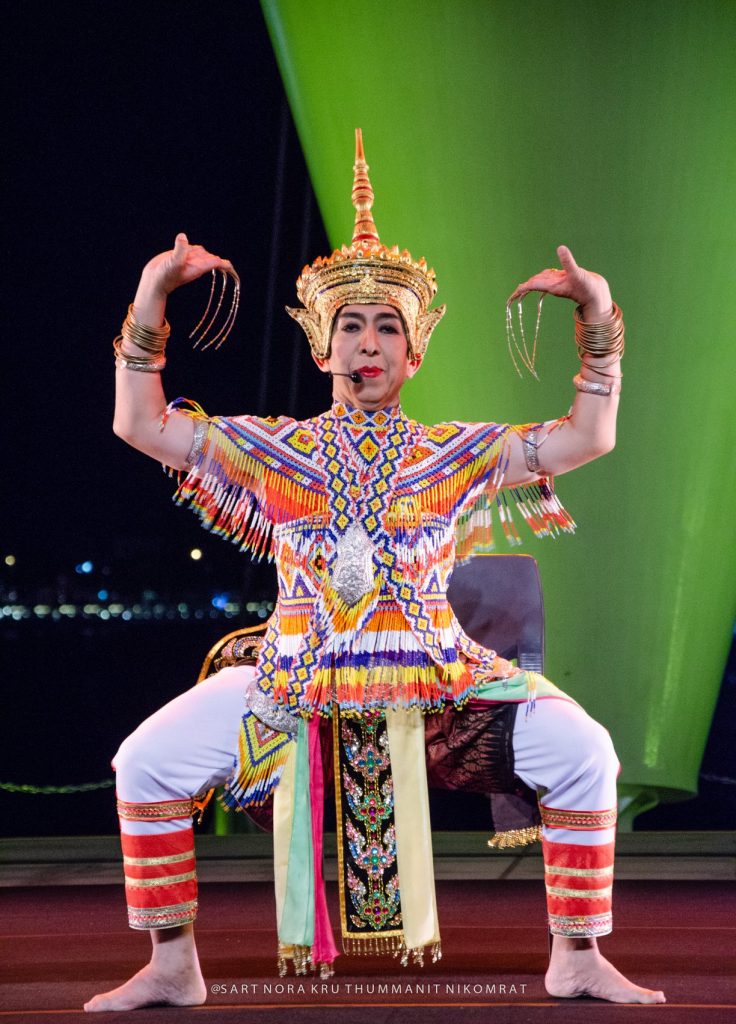
Full regalia [FB: Thammanit Nikomrat]
The costume of the main characters, called Nai Rong Yai (นายโรงใหญ่), is the most spectacular compared to other characters. While all performers wear ser, a round-neck shirt with colorful bead strings, pants, belt buckle, long cross-body chain, and the long fingernails; the Nai Rong Yai’s full costume also includes arm bracelets, a distinctive pendant, and little decorative wings called pik nok aen (ปีกนกแอ่น) or pik neng (ปีกเหน่ง).
Music
The Nora ensemble is composed of few instruments. The main instrument that controls the beats of the entire band is a pair of goblet drums called thap (ทับ) or tone (โทน), each with different pitches. Another drum, played with striking sticks, adds more vigor to the rhythm. Pi (ปี่), the Thai-style oboe, is the only instrument that creates the melody. The double gongs, small cymbals, and claves provide the tempo and keep the energy of the performance high.
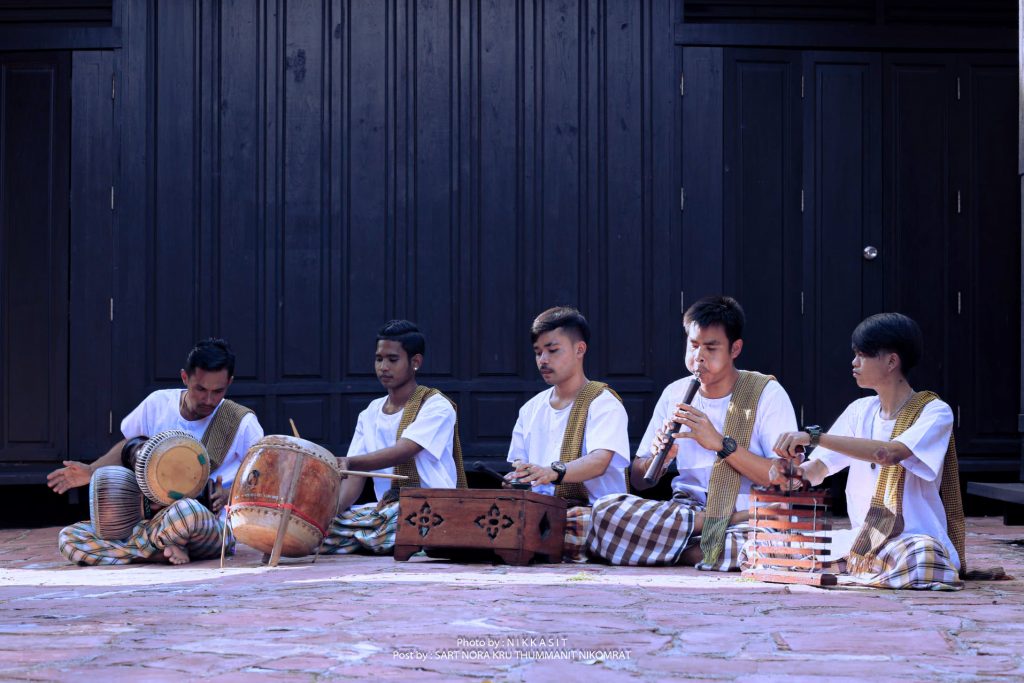
Band playing instruments [FB: Thammanit Nikomrat]
This style of musical ensemble is also used in other performance arts of the South, namely Nang Talung (Small Shadow Puppets) and Likay Pa (Jungle Opera), though variations may exist.
Performance and Ritual
There are two main types of Nora performance – the ceremonial performance called Nora Rong Khru (โนราโรงครู) and the entertaining performance called Nora Ram (โนรารำ). Both variations possess deeply spiritual elements.
Nora Rong Khru
Nora Rong Khru is a ceremonial performance held to pay respect to Nora teachers. Spirits of deceased masters, known as khru moh (ครูหมอ), are feared and revered by all Nora performers. Those who behave morally are blessed by khru moh, while those who misbehaved are cursed with sickness, misfortune, and even death. Nora Rong Khru is thus an important opportunity where dancers can demonstrate gratitude towards the masters and ask forgiveness for their misconducts. This act of reverence reflects the value of respect that has such a strong foundation in Thai culture.
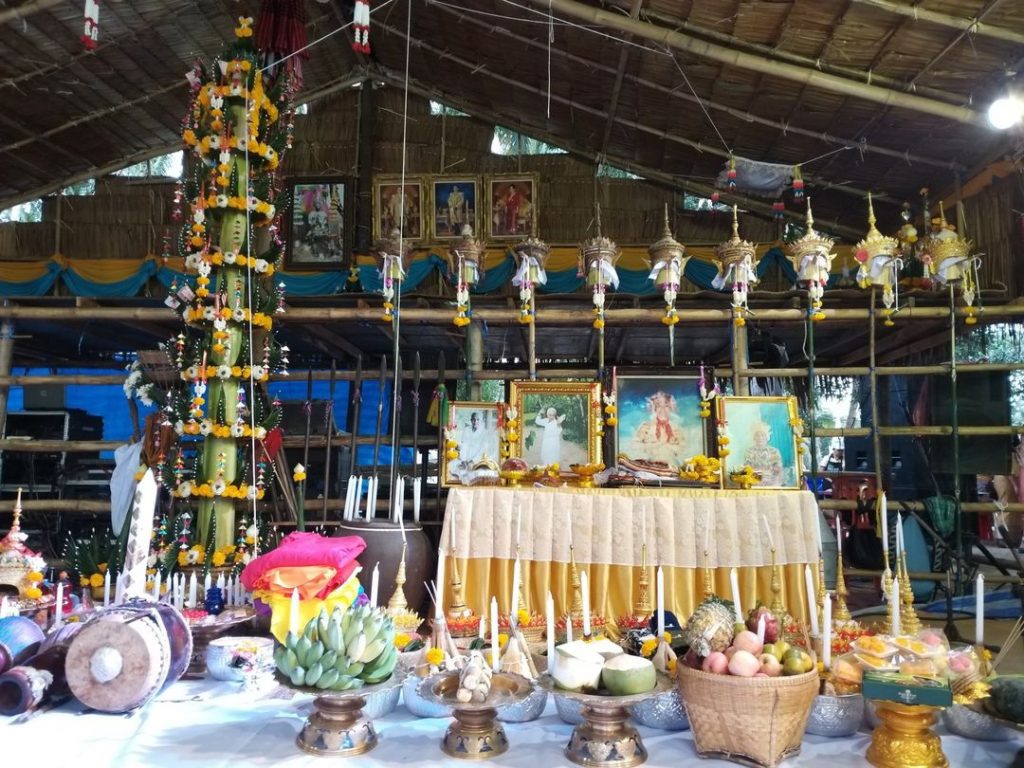
Offerings for Nora Rong Khru [cr. phatlung.com]
During the Nora Rong Khru ceremony, trainees and seasoned performers, no matter their locations, come together to pay respect to living and deceased teachers. After the worshiping rituals are done, the masters will put on a special show that usually consists of traditional poses rarely seen in today’s performances. These are open for public viewing.
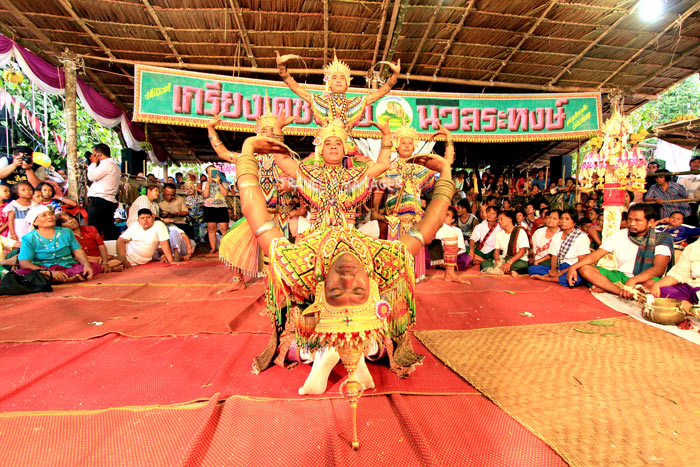
Masters perform at the Nora Rong Khru at Wat Tha Kae, believed to be the birthplace
of the ceremony [cr. Manager Online]
The full ceremony, known as Nora Rong Khru Yai (โนราโรงครูใหญ่) is held every year or every three to five years depending on the performer’s lineage. The event lasts as long as three days, beginning on Wednesday and ending on Friday. The Nora Rong Khru Lek (โนราโรงครูเล็ก) is a shorter version, usually starting on Wednesday and ending on Thursday. For both types, one of the main rituals is Khrob Serd (ครอบเทริด) where the pointed headdress is slowly lowered onto a young performer’s head as a form of initiation. Traditionally, only performers who have received Khrob Serd are allowed to put on the serd by themselves. Other dancers must have the headdress placed on by their masters. To receive an initiation, a performer must be of age and have already been ordained as a monk for a period of time.
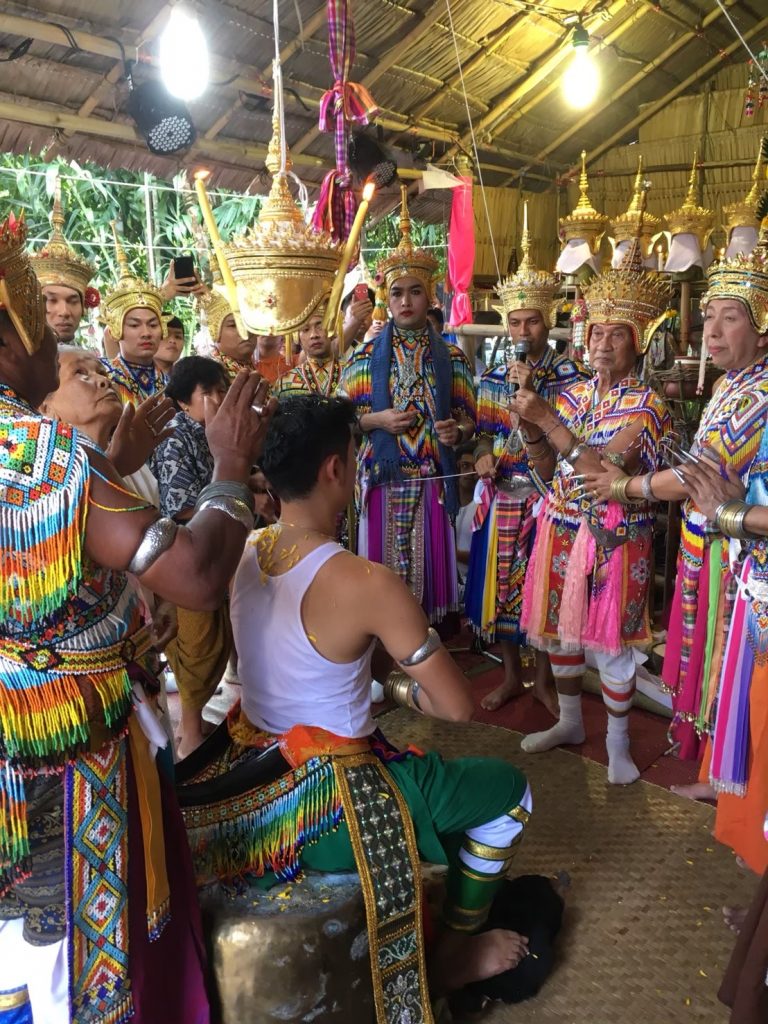
Khrob Serd ceremony [FB: Thammanit Nikomrat]
Nora Ram
Held mainly for entertainment, Nora Ram opens the opportunity for the performers to show off their talents and skills. Whether they are showcasing traditional or newly created poses, each execution has to be correct and precise. For some, this is the chance for them to display their special techniques, such as flexible arms and body. Some use their bracelets to create jingling sounds.
When performing for entertainment, a Nora troupe has a specific customary sequence to follow. Shows usually start off with melodies sung from behind closed curtain. Next, a group of actors enter the stage to dance and sing prepared verses called kham phrat (คำพรัด) or improvised verses known as mutto (หมุดโต).
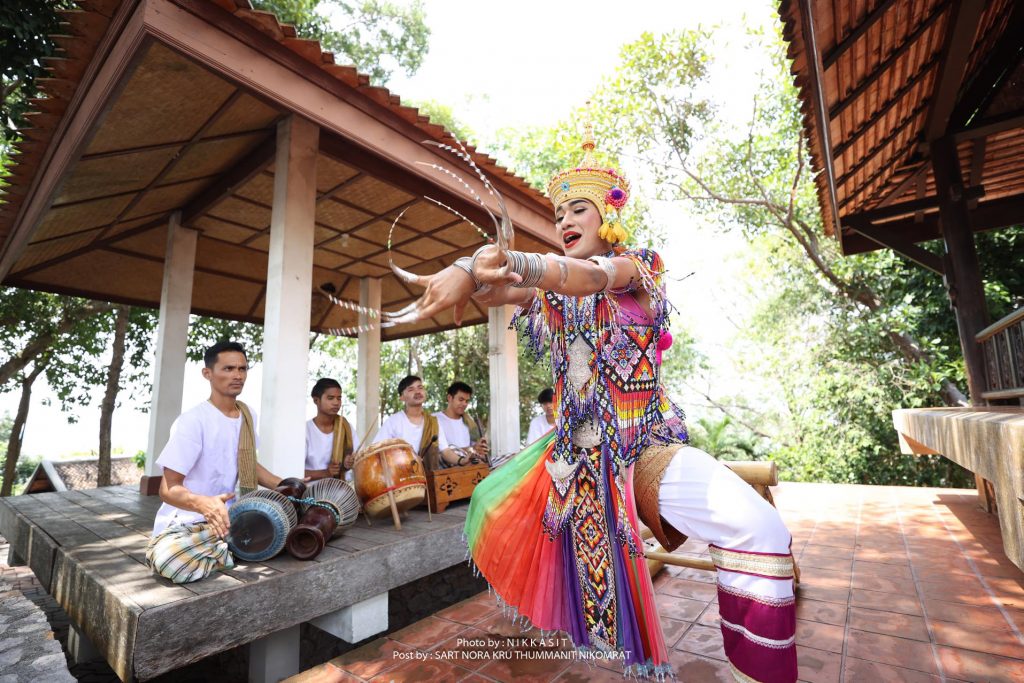
A performer dances and sings [FB: Thammanit Nikomrat]
Next is the Ok Phran (ออกพราน) dance, when a comedian comes out to delight the audiences with a humorous show. The comedian assumes the identity of hunter who is revered as a form of sacred clown. He wears a red, wooden mask with a white hairpiece is traditionally made out of pelt. The mask, called na phran (หน้าพราน), is considered to be a sacred amulet capable of inciting audiences’ affection toward the actor.
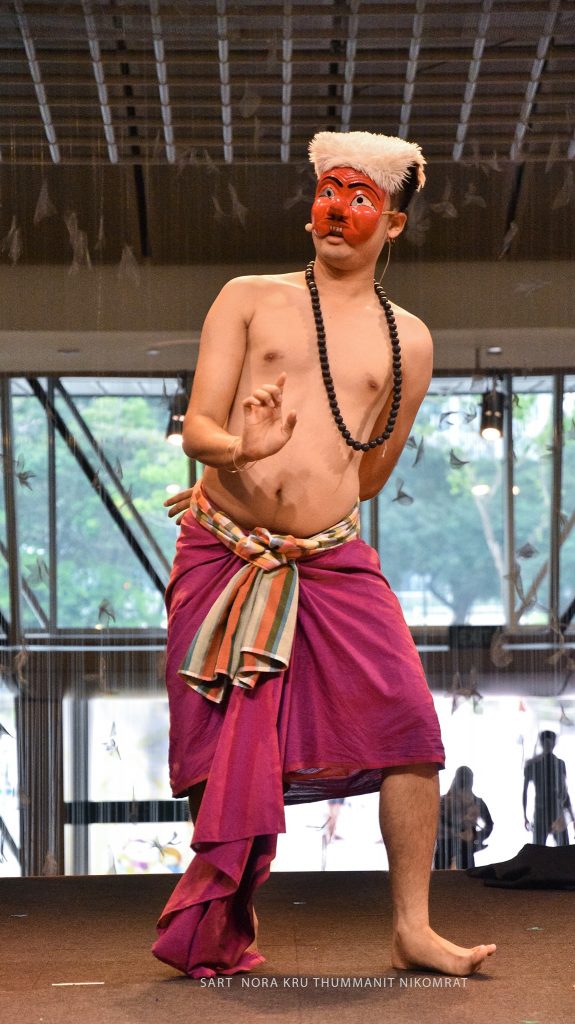
Ok Phran dance [FB: Thammanit Nikomrat]
After the prelude comes the main performance, called Ok Nai Rong (ออกนายโรง) where the main dancer showcases special dance moves, sings prepared verses, and improvises passages to suit the audiences.
The show will be more entertaining for the audience when there is a Nora battle between two or more troupes. The main performer of each troupe will perform the rites of Khian Phrai (เฆี่ยนพราย, meaning whipping the spirits) and Yiab Luk Nao (เหยียบลูกนาว, meaning stepping on lime fruits) as a spell on the rivals and to boost the troupe’s morale.
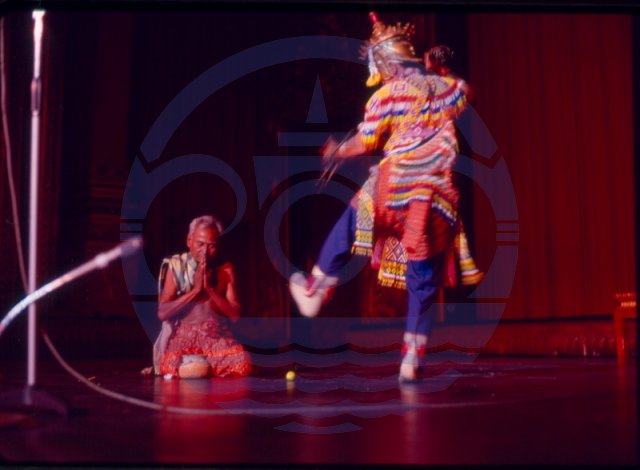
Yiab Luk Nao dance [cr. gotoknow.org]
Keeping the Tradition Alive
Even in today’s rapidly changing world, professional Nora performers live well in every corner in the Southern Thailand as well as some states in Malaysia, especially Perlis, Terrenganu, Kelantan, and Kedah, where many Malaysian Siamese live. Realizing the importance of Nora as a disciplined art form that reflects the rich culture and tradition of the South, many educational institutes engage in the study and teachings the performing art, which has surprisingly captured the interest of young people.
Although the costumes, music, dances, and lyrics remain traditional, the role of Nora has been extended to include an effective communication medium. Some government agencies communicate news and policies to villagers through Nora performances, which has proven very effective. This new role gives Nora a strong position in today’s rapidly changing world and keeps the discipline alive and well, both as a prospective career and as a cultural icon of the South.
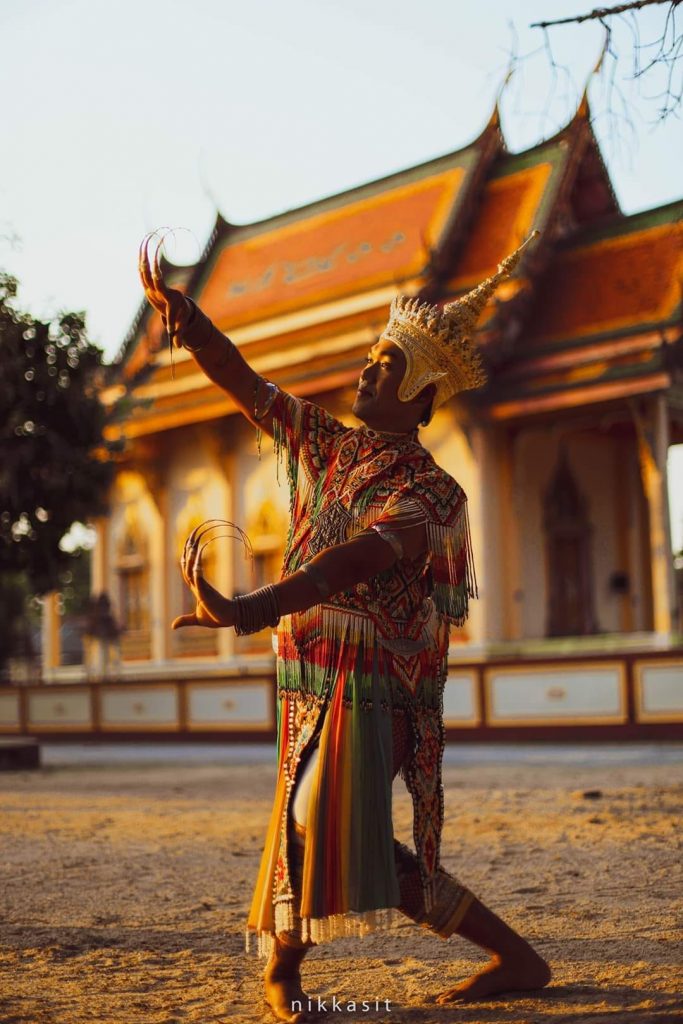
[cr. FB: เทพศรัทธา]
****************************************
Reference
Buabakdhi, Apinun. Nora Tee Sood Hang Thak Si Na Nard Ta Ya Sard [Nora: The paragon of Natya Shastra from the South]. Watthanatham Journal: Department of Cultural Promotion, vol. 57, no. 1, January-March 2018, p. 4-17. Available at http://magazine.culture.go.th/2018/1/mobile/index.html#p=7.


